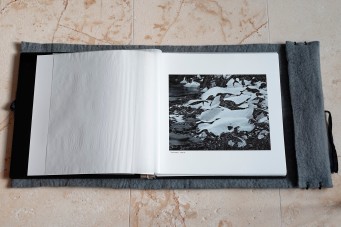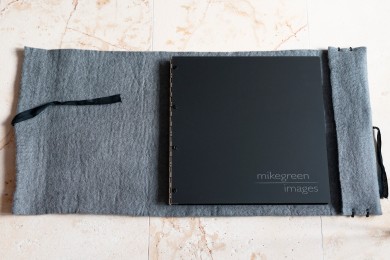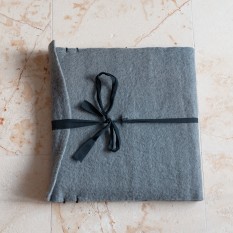A paean to printed portfolios
Don’t worry, there’s no danger of this being literally a paean, at least not in the sung or poetic sense; I just liked the alliteration and it’s really not too strong a word for the enthusiasm I feel in encouraging you to make a physical portfolio of your images. That is: actual, printed photographs bound in some kind of case or book, not a folder on the web or on your computer! I did so a few months ago and I’m very pleased with my investment of time and money.
If you already print things, and you’ve already made yourself a portfolio, you almost certainly won’t need convincing of the benefits of doing so, both the obvious ones and those which maybe weren’t apparent until you’d made it, but, importantly, I’m not writing about printing in general here; this is specifically advocating the idea of making a collection of prints as a portfolio, as a thing in its own right. If you haven’t yet done so, please read on …
Upsides
No matter how much I tell myself, and believe, that artefacts which exist digitally are just as ‘real’ as, say, a piece of sculpture, or a book, they’re real in a different way. Yes, they most certainly exist – my electronic portfolio exists every bit as much as my newly created, paper-based one – but they’re intangible. A printed portfolio is tactile; it has substance in a human frame of reference, not [questionable] substance in the form of whatever digital medium an image is stored on, only accessible via computer rendering.
No matter which particular form of words you’re happy with in differentiating types of ‘real’, prints are less ephemeral than screen-renderings and they’re accessible with more human senses. Prints in a portfolio add touch, sound, and possibly smell (!) to the singular sight available on a screen. Prints provide a far more involving form of ‘real’ than viewing images on a computer.
That’s not merely good for you, as the creator of the printed portfolio, it’s good for people to whom you show it. They too benefit from the enhanced sensory experience of perusing a set of physical prints in some form of presentation case or binder, rather than swiping a screen or clicking a keyboard (though the inclination towards excessive caution when handling the portfolio – at least in my case – may reduce the tactile aspect somewhat, as I’ll expand upon below!).
I should say here that an easy way to produce portfolios is to use transparent sleeves held into a binder, into which the prints can be inserted. Full marks to that option for flexibility and nominal ease of use, but it places a plastic barrier between the print and the viewer. To me, that removes several of the benefits and comes close to a compromise too far. I’d almost rather use a screen than peer through plastic, and if the intention is to remove the prints for viewing then regular replacement might well be in order too, not to mention that the whole viewing process is inevitably fiddly. Better to have a set of prints in a nice box, perhaps, removing those issues and giving ‘full access’ to the work?
That ‘nice box’ idea leads onto another benefit: the printed portfolio itself can be an attractive, even artistic object. This particular, perceived characteristic is made very clear indeed by the remarkably widespread availability of presentation cases into which tablets can be placed or attached, specifically for use as a photographic portfolio. There’s no real, functional benefit at all in handing someone a tablet in a wooden / leather / aluminium / whatever binder on which to view your portfolio, but it feels nicer – and, again, like a better form of ‘real’ – than just handing over a tablet ‘naked’.
That said, actual printed images in a binder or box are still better. Presenting a collection of images as an artefact in its own right gives the opportunity for additional creativity in the design of the object itself; it makes the individual works into ‘something more than the sum of the parts’. Oddly enough, a computer-based folder or web page doesn’t seem to have quite the same effect ;-)
 All of the above leads, or at least did for me, to a surprising feeling of progress in my work which I’d utterly failed to anticipate. Irrespective of the level of merit my printed portfolio and the images in it represent, the process of designing and constructing it was involving, required a fair bit of thought, and was ultimately very rewarding; far more so than I’d expected. Producing the object was very emotionally engaging and it made me feel that I’d moved on with my photography. No matter how many images you store on a hard drive, and how nicely they’re organised, the feeling of “I made this” is much more satisfying and convincing with the physical object!
All of the above leads, or at least did for me, to a surprising feeling of progress in my work which I’d utterly failed to anticipate. Irrespective of the level of merit my printed portfolio and the images in it represent, the process of designing and constructing it was involving, required a fair bit of thought, and was ultimately very rewarding; far more so than I’d expected. Producing the object was very emotionally engaging and it made me feel that I’d moved on with my photography. No matter how many images you store on a hard drive, and how nicely they’re organised, the feeling of “I made this” is much more satisfying and convincing with the physical object!
Downsides
Of course, printing things is a lot more effort, far less flexible, and requires some input of money and time. All those things have led to my being initially somewhat cautious in handling the finished item: white cotton gloves, a thick, felt cover for the scratch-able, acrylic cover and, the first time I took it anywhere, a plastic bag as a cover to protect the felt cover-cover which I’d by then decided was also rather nice … (fortunately, I used a refreshingly unattractive plastic bag for the cover-cover-cover!).
You need to store it somewhere too. My twenty-three prints in their portfolio take up infinitely more space than the numerous digital copies and backups of them I also possess! So what though: I like collecting photography books and have written about the allure of photographic monographs before; this is merely a personalised, loose-leaf version of one on fine art paper, so I’m not overly bothered by the space issue.
And none of the other downsides is all bad; I’d argue that some sense of the need to care for the object enhances the experience of having created both it and the images it contains.
The major benefit
Most importantly, and the reason I’d urge anyone to create a physical, printed portfolio is that I now attach more emotional value to the portfolio-as-object than I ever did, or ever will, to the electronic versions of its contents; the prints mean more to me than they did before; they have more substance in both the literal and metaphorical sense. That feeling of having made something ‘more real’ was undoubtedly worth all the effort.


11 Responses to “A paean to printed portfolios”
Mike,
That’s a beautiful object. It’d be interesting to know more about the production process :-)
Thanks,
Mark
Thanks Mark! I may well write a short addendum on making it and the choices involved. I didn’t want to contaminate the basic point of this article – ‘go make a portfolio – you won’t regret it’ – by talking about choosing components and such. It was certainly more complex, more choice-rich, than I’d imagined when I initially thought “it would be nice to make some prints and stick them in a folder of some kind”. It was really quite easy to produce, physically, but the range of decisions to make is somewhat extensive! Fun though :-)
That looks like such a lovely book Mike, well done. I couldn’t agree more with what you say here. Though not about prints per se, there’s is something beautiful and mysterious about the print as a physical object that it’s impossible to appreciate from an image on screen. Indeed, some images really only come to life when printed out and give you a whole new sense of satisfaction.
Taking that further to printing and creating a whole portfolio takes the magic further. It’s something about the craftsman in us, creating a beautiful physical object that people can touch, sense, wonder at is quite a remarkable thing. Going out, making the images, and then crafting something that exists in the real world. How wonderful! I guess the next stage is to make our own cameras :)
Would love to hear more about what you did in another post, it’s certainly a beautiful thing.
Thanks Duncan. I was concentrating on the portfolio itself, but that arose from discovering how much better prints are than screen-renderings, so it’s all part of the same thing of course. And yes, I should have mentioned that much of the appeal and reward is the craft element. How about making a pinhole camera and a portfolio of images from it? ;-)
printing makes something last for far longer time…computers can crash, cds or dvds can crash and it is easier to show a group of people a book…excellent choice…
Thanks Gary. You’d be surprised how …. ‘involved’ it is to make prints last though ;-) Still this should last longer than me!
Mike, me it took several years until I learned to value the paper print of a photography as a physical object. But now I am in the process of creating my third portfolio (with the help of Danecreek folio covers) and have found so much additional beauty in good paper – it certainly is another level than monitor-bound imagery.
It’s taken me a little over three years, but I’m glad I decided to do it :-) Whether I’ll create multiple portfolios or cycle new images into this one is another question which I’ll have to muse on over a period of months I think! ‘Another level’, as you say. Thanks for commenting.
[…] Mike Green postet his "Paean to printed portfolios", Ctein rambled "About Printers" on T.O.P., and Brooks Jensen of Lenswork fame podcasted on "The […]
Hello, I have enjoyed reading your thoughts and quite agree. Just lately I have felt frustrated by the poor quality of quick prints from my supermarket penny in the slot machine, and have longed for those decent-sized black and white images on photo paper that I used to have. I have just bought a film camera and intend to try it for a while- sending the film away and getting my prints back will be a pleasant feeling again (although much more expensive now). I too felt the need for a portfolio of mounted prints last year and found that Silverprint in the UK sell finely made archive cases that look very professional, though lack the hand crafted feel of your own.
[…] Mike Green postet his “Paean to printed portfolios”, Ctein rambled “About Printers” on T.O.P., and Brooks Jensen of Lenswork fame podcasted […]